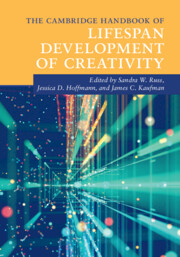Book contents
- The Cambridge Handbook of Lifespan Development of Creativity
- The Cambridge Handbook of Lifespan Development of Creativity
- Copyright page
- Dedication
- Contents
- Figures
- Tables
- Contributors
- Acknowledgments
- Introduction
- Part I Core Concepts of Lifespan Creativity Development
- Part II The Development of Creativity
- 5 Are Preschoolers Creative?
- 6 Development of Creativity in School-Age Children
- 7 The Development and Enhancement of Adolescent Creativity
- 8 The Intertwined Development of Identity and Creativity
- 9 Creative Development in Children from a Measurement Perspective
- 10 Creativity in Adulthood
- 11 The Many Faces of Creativity in Old Age
- Part III Modes of Enhancement
- Part IV Environments and Contexts
- Part V Special Populations
- Index
- References
11 - The Many Faces of Creativity in Old Age
from Part II - The Development of Creativity
Published online by Cambridge University Press: 19 November 2021
- The Cambridge Handbook of Lifespan Development of Creativity
- The Cambridge Handbook of Lifespan Development of Creativity
- Copyright page
- Dedication
- Contents
- Figures
- Tables
- Contributors
- Acknowledgments
- Introduction
- Part I Core Concepts of Lifespan Creativity Development
- Part II The Development of Creativity
- 5 Are Preschoolers Creative?
- 6 Development of Creativity in School-Age Children
- 7 The Development and Enhancement of Adolescent Creativity
- 8 The Intertwined Development of Identity and Creativity
- 9 Creative Development in Children from a Measurement Perspective
- 10 Creativity in Adulthood
- 11 The Many Faces of Creativity in Old Age
- Part III Modes of Enhancement
- Part IV Environments and Contexts
- Part V Special Populations
- Index
- References
Summary
The focus of this chapter is on diverse forms of creative expression in old age using a life-course framework. We consider age-related changes in opportunities for and expressions of creativity. Social and environmental influences on late-life creative expression are explored. We link our understanding of late-life creativity to traditional aspects of creativity studies, including creative potential, eminent creativity, and everyday creativity. Consistent with our life-course orientation, we consider age-related changes and differences in the above forms of creativity. We review creativity-enhancing interventions in relation to everyday creativity. A major contribution of our work relates to focus on the use of proactive problem-solving strategies to address late-life challenges creatively. Novel solutions to normative stressors of aging pose exemplars of the value of late-life creativity. Creative problem solving is proposed as key to ensuring a meaningful and successful old age.
Keywords
- Type
- Chapter
- Information
- The Cambridge Handbook of Lifespan Development of Creativity , pp. 233 - 262Publisher: Cambridge University PressPrint publication year: 2021



